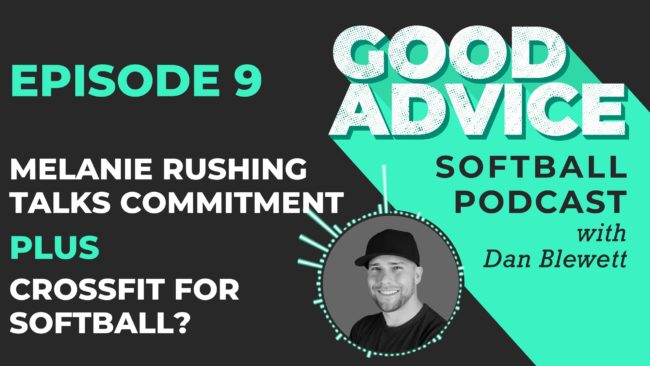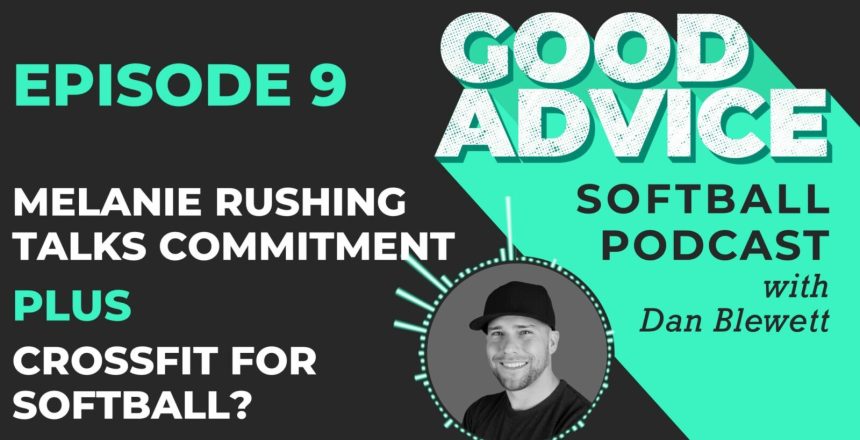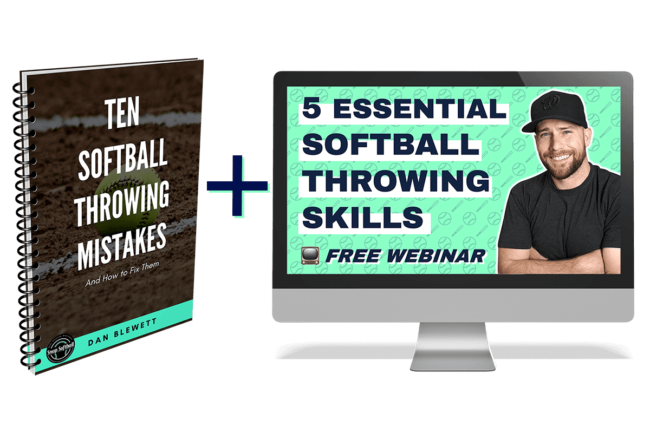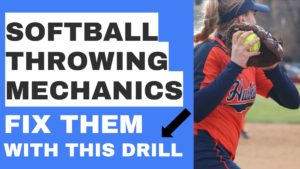*This article may contain product links which pay me a small commission if you make a purchase. Learn more.
Melanie Rushing, host of the softball podcast The Mental Sweet Spot and former collegiate coach, came on the show to give three great culture tips for teams and players. She shares insight that can make a big difference for teams of all ages. In the 90-second mindset portion, Dan discusses crossfit training and whether it’s a good fit for softball, and also covers expensive bats in the Q&A portion of the show.
Listen and subscribe to Melanie’s podcast here, and check out her awesome team culture bootcamp – it’s a must for coaches who want to improve their dynamic on the field. Follow her on Twitter @CoachMelRushing
To submit a question for the Good Questions Q&A segment, make a voice recording and email it to Dan at hello@danblewett.com. Want to support the show? Enroll in one of Coach Dan’s online throwing courses or his mental skills course. Use code GOODADVICE to save 20% on any course, just for being a listener. Sign up for Dan’s Email list and get his free throwing eBook, and follow up with him on the interwebs: YouTube Channel | Twitter | Snapsoftball.com
Podcast: Play in new window | Download
Subscribe: Apple Podcasts | Spotify
Transcript: EP9 – Melanie Rushing on Team Culture; Crossfit Training For Softball? And Are Expensive Bats Worth It?
Dan Blewett: You are listening to the good advice, softball podcast. I’m Dan Blewett. And on this show, you’ll learn how to help the softball player in your life. Sharpen her skills, improve her mindset. And find new competence through softball.
welcome back to the good advice softball podcast. I’m Dan Blewett on today’s episode, we actually have a great guest Melanie Rushing. We’ll be sharing some of her team culture tips. If you’re not familiar with her and her work, she is the founder of the mental Sweet Spot runs a great team culture boot camp, and also the, uh, she’s the cohost of the.
Coaching the Mental Game of Softball Podcast. So definitely check that out. I put links in the description below, so you can get in touch with her on Twitter, her websites, and her podcast. So she’s going to share a couple of tips today. We’re also going to cover CrossFit training for softball. Is that a good idea and are expensive bats actually worth the higher sticker price?
All right. So first thing, let’s jump into Melanie Rushing’s three tips for improving commitment. And this is a big part of, of team culture is improving commitment of each player and coaches, uh, to their craft, to the sport, to each other. All that great stuff. So let’s jump into Melanie.
Melanie Rushing: Melanie rushing here, co founder of mental sweet spot and cohost of the coaching, the mental game of softball podcast.
And today I’m here to talk to you about one of the most common questions we get asked all the time. How do I get my girls to be more committed? Let’s type in one of the first mistakes people usually make, not just players, but coaches, parents, people, humans, uh, is we focus so much on our, the goals that we forget about the why.
So one of the first things I want you guys to do to stick with that commitment, right. And make sure that they’re bought in for the right reasons is tapping into why they’re doing this. And it’s not just because I love softball. That’s always the first answer. Okay, but that’s a little surface-y. I want you to dig a little deeper.
So think about your goals and then imagine you’ve achieved. All of them worked out exactly as planned. You’re looking back on your career at the season, or just the game where you went just the end of a practice and you’re feeling something. What is that feeling? That is your wife. Are you feeling proud?
Are you feeling satisfied as a coach? Are you feeling like you helped them? Are you feeling as a parent that you’re proud? What are those feelings that is your why? And when you have your goals in mind, when you’re going from day to day, you can always tap back into that feeling and immediately increase your motivation.
That is how you stay committed you. And on the tough days, Another well-intentioned mistake is telling them how they should think. Act, feel be a, you should be committed. You should be bought in. You should be putting an extra what is going on with you. I know that’s what we want for them, but it’s got to come from them.
So what I encourage you to do is ask them, okay. What will it take for you to get those goals, to get that feeling? You said you want it in the last tip, right? What is it going to take day to day? What’s it gonna take in practice in games? What do you have to do? Who do you have to B? And it’s amazing. A lot of times the things they come up with come up with simple words.
I’ve gotta be, uh, bought in. I’ve got to be motivated. I’ve got to be positive. The things that they come up with are typically the things you’ve been saying to them anyway, but when it comes from them, you can use. Their language to just gently remind them, Hey, you said you needed to be committed for this.
So let’s go take some extra reps. I’m here for you. Or if you need some extra help, I’m here that way. It’s coming from them. And they’re building that culture that you’re hoping they bring to the team. Right. But that’s how you get them bought in is let them come from their mouths. Not just from you preaching it.
All right. The third mistake that we make that I think I’m just now starting to get people on board. Is we over me? So the intention is fantastic. Of course, we want to teach players how to be a part of a team and partisan bigger and make small sacrifices for something better. But the problem is when you say we over me, we as up here.
Then it’s more important than what I feel. Well, I think what I’m contributing instead, you flip it to me four weeks. That way I’m focused on what I can do, not what my teammate is doing wrong over there or what this person should be doing, but they’re not, it switches from blame and fault to ownership.
All right. What can I do to better? My team is also more controllable, so all right. This is me. This is what I bring. This is my strengths, and this is how I can help my team succeed, help my teammates have fun, have fun together. You see how it’s more empowering that way. So if you have the me for weed mentality, it helps them stay motivated.
Cause that’s what internal motivation is. Right. All the research from sports psychology from leadership from education says the best motivation comes from inside. So that’s me for we.
Dan Blewett: All right.
So let’s, let’s chat a little bit about Melanie’s tips here. She gave some really great insight and I think my favorite was her first one where she’s talking about, you know, why do you play?
And this is something that we all as athletes and as, as parents and coaches need to think about, because. At the end of the day, like she said, when you retire, what do you look back on? And what did you want to be as a player? What did you want to accomplish? And, and what really made you smile? What made you proud?
What made you excited? Like what are the things that you missed? I think as a parent or a coach, trying to get your players to work harder, which is what Melanie touched on a ton of in her second tip, you know, you have to know what drives people and for some people. Their drive isn’t to be, you know, renown this big celebrity player.
Um, for a lot of people, they just want to be part of a good team. They just want to be in the, in the mix and in the Folden, um, with their buddies. And that’s the biggest thing for them. They just want to get this boost from being around other people. Some people really want to compete. Um, some players really, they want this, they want to look back and say, like I was highly respected or I tapped out my potential.
Whatever it is, and those are the things that really motivate. So everyone’s different. And, um, you know, sports change as you get older, this is another really important thing to remember. They’re not as silly fun, like when you’re a kid, like it’s not like playing in the backyard as it gets more competitive.
And that’s where again, uh, what million touched on the why is, is important because as it gets harder and you have to work harder and you start to suffer injuries and really long days of the field, Maybe tough coaches, all this stuff. Um, it still comes back to why’d you do it. And if comes a job and if you don’t really know, then it’s tough to put in the extra work to be as good as you can be.
So some really great advice here by Melanie rushing. Want to thank her again for being on the show, be sure to check her out, all the links to all of her stuff. And she does a great job on the web. Is in the description link below. So if you’re listening on iTunes or Spotify on you or on YouTube, all of her info is there highly recommend you check her out, follow her on Twitter, on Instagram, all that stuff, and check out her team culture, bootcamp, which is a great thing for someone which is an insurance
90-second mindset. Let’s talk about CrossFit. So in our last episode, chat a little bit about yoga. Is that a good training method said, Hey, let’s talk about CrossFit. So obviously CrossFit Rose to prominence in the last 10 years or so maybe it’s a little more than that now. And it gained fame because it was.
Very hard, got a lot of people off their couches, got a lot of people lifting weights in a very real way. For the first time, you know, a lot of especially adults, it was either I just kind of are jog or I don’t really exercise, or I go to the gym and I do these machines. I don’t really know what I’m doing and it doesn’t really work that well.
And then suddenly they’re thrust in this environment where they’re using barbells and real weights and free weights and doing a lot of stuff at high intensity and competing with each other in a community. So there’s a lot of really good things that came out of CrossFit and it got, again, a lot of people exposed to quote unquote, real strength training for the first time.
But some of the, the cons and this is coming from me as a strength coach. Cause this is what I did for the last 10 years. Um, the program design isn’t very well suited for specific goals. And I think CrossFit would admit that that their goal is to be a generalist that they, you know, you feel watched the CrossFit games, you have to, you know, throw 200 pounds over your head, then sprint.
And then, you know, dude, 20 pull ups and, you know, throw a ball off a wall. They’ve a really, really wide assortment of tasks. And they’re trying to find the fittest person on earth, which is a very general thing. Right. But as an athlete who specialized in the sport, whether you’re a sprinter, whether you’re a swimmer, whether you’re a softball player, football player, you’re not a generalist.
And now in the weight room, most athletes will do most of the same exercises. You know, I’d say for probably 80% of your workout, you know, a football player is going to do the same stuff as a, as a volleyball player or a softball player or a swimmer because the human body is the human body. Right. We need strong back.
We need strong glutes. We need strong quads. We need strong hamstrings. Everyone needs those, no matter what sport you play. And then the other 20%. Is typically the sports specific stuff like, so for softball, it’s more arm care exercises, their shoulders, shoulder, stuff like that keeps your throwing arm healthy.
There’s more core training. There’s more rotational core train. There’s more stuff like that. And maybe a little less emphasis on some like that. The brute force that you might need in football or other sports like that. So those needs get finely tuned now. If you do CrossFit, you’ll get a lot of the general stuff.
Like you’ll definitely get stronger. You’ll definitely get bigger, but you won’t get the sports specific stuff. You’re not going to get the rotator cuff strengthening. You might not get the forearm strength and you might not get the rotational core training. That’s really going to apply more specifically to your bat speed or your throwing speed.
There, you’re not going to get the lateral hip, um, strengthening that is important to prevent ACL tears in female athletes. So there’s lots of different stuff that just isn’t part of like the CrossFit methodology. And this isn’t to say that CrossFit is bad, cause it’s not, it’s just not built for any specific athlete in general.
And to be at your best, you ultimately want to spend your finite training time. Training in the most specific way you’re going to be doing right. Like that makes sense. If you’re going to be an accountant, you’re probably spending more of your time in college, doing accounting and learning high level math and statistics and all that stuff.
You know, if you want to be an accountant, you’re probably not going to spend most of your time. Doing psychology and studying archeology and doing all this other general knowledge stuff, which is important and good for being well rounded, but not necessarily making you great civic job. So softball is really your thing.
And you’re considering doing CrossFit. If it’s your first go around with fitness, it might be a good foray, a good intro into it for a year or two. Um, and it’s certainly not gonna, I mean, it can be. Dangerous depending, but if you have a good coach and if you’re smart about it, it can be reasonably safe. Um, but if you’re really trying to be your best, I would recommend against CrossFit and I’d find a good strength coach with a good sports performance facility where you then can go and get a softball plus a specific workout.
Which is still going to be extremely challenging, extremely, uh, real lifting, quote unquote. There’s not that much different between real strength training that, you know, a high level athlete would do in college and a CrossFit workout in the sense that. You’re still using really big compound lifts. You’re using heavy weights.
You’re challenging yourself. Um, there’s a lot of really good stuff going on that crossroad didn’t invent crossroad just sort of had their own package and their own sort of exercises that they sort of choose as part of CrossFit. And they don’t really go beyond that, that much. That’s why, again, You’re not going to see softball, specific stuff ever and CrossFit workout.
So these are all just some ideas to throw out and something to consider because your training time is yours and you don’t get it back. So if you’re spending an hour a week or two hours a week or three hours a week or four hours a week on strength training, you should make, you’re getting the most bang for your buck and you should really consider what type of training method is best for you.
Alright, it’s time for good questions. Our listener Q and a segment. Remember if you have a question you’d like answered on the show, please email a voice recording to hello@danblewett.com. This is easy to do on your phone through the voice memos app on iPhones or any voice recorder app on Android links to email me are in the show notes.
All right. Lastly are expensive bats worth it. So this was a question I used to get a bunch cause parents always come into our Academy and they’d say, Hey, like, um, I’m thinking about this bat or this bat. Do you have an opinion? Do you know much about them? So on my other podcast, one of my other podcasts, uh, we had a physics of baseball professor from the university of Illinois named Alan Nathan.
He’s one of the, the, um, Forefront or the one of the foremost baseball physics researchers in the country, he’s been part of creating bat standards. So like BB core in baseball, he was part of creating that standard. And in many, many talks because Allen I’ve been friends for a number of years now. In, in asking him what are, what are these bat standards do?
And what’s the difference between bats at different price points? Like they all are regulated, right? They can’t go above a certain, um, exit speed coefficient. So if they’re all regulated, What’s the difference. And I guess the analogy would be here, like say, all cars were not allowed to go over 60 miles per hour.
You might ask yourself, then what’s the difference between a Toyota and a Ferrari. If they can both only go 60 miles per hour, why would I spend $80,000 on a Ferrari versus dollars on a Toyota? And that’s, it’s a very reasonable question and that’s kind of how these bats operate, and this is not baseball or softball, softball specific it’s for all of them, they all have a regulatory stamp on them.
Now that says. A batted ball could only leave his bat at such a high speed. So basically what you’re getting when you’re paying for a more expensive bat. And this is as explained to me again from one of the world’s experts on that physics and bat construction is that you’re trying to, you’re paying for getting closer to being illegal essentially.
And this is probably something you already subconsciously realize that if you spend $4 on a bat, It’s going to be closer to exceeding the standard. It’s going to be as barely legal as possible. Whereas if you spend a little less money, maybe it’s not quite as close to that standard. Whereas a manufacturer it’s probably tough to really get about fine tuned where it’s almost illegal, but still barely legal.
That’s a tough thing to do because they’re going to have to get it tested and certify that it is in fact legal. And if they get too close to the line with his bat prototype, they developed. It’s a big research risk where they might, man. We like, we put all this money into research and design and now the bats failed and we had to kind of start over and they don’t want to do that.
So in a sense, you’re paying to get more performance close to that limit. So again, like maybe the Ferrari can go 59.9 miles per hour, but your Toyota can only go 58 miles per hour. Now. In baseball, for example, this might be a bigger difference because the ball is hit so much farther. And the difference in say, say you get 1% better performance from more expensive bat, rather than a cheaper bat.
Well, 1% for a college baseball player might be four feet or five feet. They can hit a ball for 400 feet. Whereas for softball player, that’s only two feet. Right. Well, not two feet, but let’s say your max is 300 feet, which is a bomb or your max is 250 feet. You’re only getting maybe two to three extra feet of flight.
If you get 1% extra performance, if that’s, and that’s just an arbitrary number that I just made up. So I think. It’s right to ask yourself how much performance am I actually getting from? Maybe double the price, you know, for an hour bat versus a $200 bat it’s reasonable to ask, but really what you’re probably paying for is some fancy technology.
Like, Oh, it’s got carbon fiber, or it’s got a vibration, you know, like when you hit the wall poorly and it stings your hands, got a vibration damper. And really you’re probably paying for graphics. Um, the prettier bats, the ones that look really, really cool. Those are the ones that are more expensive. Right.
And I think they’re smart about putting their best graphic design on the most expensive bats. Cause it, man, that thing looks cool. Like I can see myself swinging it. You know, you look good, you play good. And that kind of stuff. Um, I think you can see the design and all that stuff really. Increased with the price point.
So as a parent, if you’re looking to dispend a little as money, I know it might be hard cause your daughter falls in love with that really expensive, pretty nice bat. And boys are the same exact thing. They want the coolest looking bat. Um, but you’re probably not getting much performance. Increase as you go up, because again, they are all regulated.
They can’t exceed a certain standard and it still pays for those back companies to perform pretty well. So if you get a $200 bat, they still want that bat to perform well for you. So it’s probably not very far off of the regulation standard. So just let me make it something to consider. I know for everyone is the costs of youth sports increases.
Making smart decisions is paramount. So when you’re thinking about a really expensive bat, you know, just remember number one, the biggest thing is the operator, not the tool. This goes for everything. You know, as a, as I work on YouTube, for example, I have a nice camera, but I don’t need a $5,000 camera. And this is whatever one recommends.
If you start to look up creators and people in the industry, what kind of microphone do I need? What kind of camera do I need to be good at? You know, to make good videos, like everyone says who’s been in the industry long enough, says it’s not about the camera. Get a good enough camera. And then it’s about your creativity.
It’s about how well you tell the story is about how well you use it rather than how expensive your camera is. You can have a great expensive camera and get a poor quality video, poor quality movie, because you’re just not very good at operating it. It’s the same thing with, with a softball bat. If you’re not there to swing that thing, if you’re not picking good pitches to drive, if you’re not having good plate discipline, able to bear the ball up, putting in the time in the cage, having a more expensive bat, doesn’t matter.
I mean, it’s going to be a small increase, regardless if you spend a lot. And it’s really going to come down to operator error. And the last thing I would say is when I visited the Dominican Republic kids down there, as they played against our American team, kids were swinging wood bats most of, most of the time.
And then when they had a metal bat, they were so heavily used that they didn’t have any paint left on them. And kids were still smashing balls with these. Bare aluminum bats that have been hit so many times they didn’t have any paint. So when you think about how important is this bat to my daughter’s success, just remember, it’s probably not that important.
The difference between bath is probably very, very small. And so really, um, it’s a. Important question to ask yourself, how much should I invest in a bat? And is this investment worth it? That’s all the good advice I’ve got for today. If you enjoy the show and would like to support me while also helping yourself enroll today in one of my online softball courses.
My she’s got a cannon throwing courses, come with pricing plans for any budget. And my resolute athlete, mental skills course will help your daughter or team build the mindset of a champion enroll in any of my courses through the links in the show notes and save 20% with code good advice just for being a listener.
Be sure to subscribe to my weekly email list where you’ll get updates on all my new videos and episodes, nearly 4,000 people get my emails and you should too. Sign up for the link in the show notes. Lastly, who do you know, who can use some good advice? Please share this podcast with a friend, subscribe on iTunes, Spotify, or wherever you listen to podcasts and subscribe to my snap.
Well, YouTube channel where you’ll find this podcast and hundreds of softball, instructional videos. Back when I was a player, I was always thankful for good coaches and good advice. I’m Dan Blewett and I’ll see you next time.







